9.6: Stems
- Page ID
- 12229
\( \newcommand{\vecs}[1]{\overset { \scriptstyle \rightharpoonup} {\mathbf{#1}} } \)
\( \newcommand{\vecd}[1]{\overset{-\!-\!\rightharpoonup}{\vphantom{a}\smash {#1}}} \)
\( \newcommand{\dsum}{\displaystyle\sum\limits} \)
\( \newcommand{\dint}{\displaystyle\int\limits} \)
\( \newcommand{\dlim}{\displaystyle\lim\limits} \)
\( \newcommand{\id}{\mathrm{id}}\) \( \newcommand{\Span}{\mathrm{span}}\)
( \newcommand{\kernel}{\mathrm{null}\,}\) \( \newcommand{\range}{\mathrm{range}\,}\)
\( \newcommand{\RealPart}{\mathrm{Re}}\) \( \newcommand{\ImaginaryPart}{\mathrm{Im}}\)
\( \newcommand{\Argument}{\mathrm{Arg}}\) \( \newcommand{\norm}[1]{\| #1 \|}\)
\( \newcommand{\inner}[2]{\langle #1, #2 \rangle}\)
\( \newcommand{\Span}{\mathrm{span}}\)
\( \newcommand{\id}{\mathrm{id}}\)
\( \newcommand{\Span}{\mathrm{span}}\)
\( \newcommand{\kernel}{\mathrm{null}\,}\)
\( \newcommand{\range}{\mathrm{range}\,}\)
\( \newcommand{\RealPart}{\mathrm{Re}}\)
\( \newcommand{\ImaginaryPart}{\mathrm{Im}}\)
\( \newcommand{\Argument}{\mathrm{Arg}}\)
\( \newcommand{\norm}[1]{\| #1 \|}\)
\( \newcommand{\inner}[2]{\langle #1, #2 \rangle}\)
\( \newcommand{\Span}{\mathrm{span}}\) \( \newcommand{\AA}{\unicode[.8,0]{x212B}}\)
\( \newcommand{\vectorA}[1]{\vec{#1}} % arrow\)
\( \newcommand{\vectorAt}[1]{\vec{\text{#1}}} % arrow\)
\( \newcommand{\vectorB}[1]{\overset { \scriptstyle \rightharpoonup} {\mathbf{#1}} } \)
\( \newcommand{\vectorC}[1]{\textbf{#1}} \)
\( \newcommand{\vectorD}[1]{\overrightarrow{#1}} \)
\( \newcommand{\vectorDt}[1]{\overrightarrow{\text{#1}}} \)
\( \newcommand{\vectE}[1]{\overset{-\!-\!\rightharpoonup}{\vphantom{a}\smash{\mathbf {#1}}}} \)
\( \newcommand{\vecs}[1]{\overset { \scriptstyle \rightharpoonup} {\mathbf{#1}} } \)
\( \newcommand{\vecd}[1]{\overset{-\!-\!\rightharpoonup}{\vphantom{a}\smash {#1}}} \)
\(\newcommand{\avec}{\mathbf a}\) \(\newcommand{\bvec}{\mathbf b}\) \(\newcommand{\cvec}{\mathbf c}\) \(\newcommand{\dvec}{\mathbf d}\) \(\newcommand{\dtil}{\widetilde{\mathbf d}}\) \(\newcommand{\evec}{\mathbf e}\) \(\newcommand{\fvec}{\mathbf f}\) \(\newcommand{\nvec}{\mathbf n}\) \(\newcommand{\pvec}{\mathbf p}\) \(\newcommand{\qvec}{\mathbf q}\) \(\newcommand{\svec}{\mathbf s}\) \(\newcommand{\tvec}{\mathbf t}\) \(\newcommand{\uvec}{\mathbf u}\) \(\newcommand{\vvec}{\mathbf v}\) \(\newcommand{\wvec}{\mathbf w}\) \(\newcommand{\xvec}{\mathbf x}\) \(\newcommand{\yvec}{\mathbf y}\) \(\newcommand{\zvec}{\mathbf z}\) \(\newcommand{\rvec}{\mathbf r}\) \(\newcommand{\mvec}{\mathbf m}\) \(\newcommand{\zerovec}{\mathbf 0}\) \(\newcommand{\onevec}{\mathbf 1}\) \(\newcommand{\real}{\mathbb R}\) \(\newcommand{\twovec}[2]{\left[\begin{array}{r}#1 \\ #2 \end{array}\right]}\) \(\newcommand{\ctwovec}[2]{\left[\begin{array}{c}#1 \\ #2 \end{array}\right]}\) \(\newcommand{\threevec}[3]{\left[\begin{array}{r}#1 \\ #2 \\ #3 \end{array}\right]}\) \(\newcommand{\cthreevec}[3]{\left[\begin{array}{c}#1 \\ #2 \\ #3 \end{array}\right]}\) \(\newcommand{\fourvec}[4]{\left[\begin{array}{r}#1 \\ #2 \\ #3 \\ #4 \end{array}\right]}\) \(\newcommand{\cfourvec}[4]{\left[\begin{array}{c}#1 \\ #2 \\ #3 \\ #4 \end{array}\right]}\) \(\newcommand{\fivevec}[5]{\left[\begin{array}{r}#1 \\ #2 \\ #3 \\ #4 \\ #5 \\ \end{array}\right]}\) \(\newcommand{\cfivevec}[5]{\left[\begin{array}{c}#1 \\ #2 \\ #3 \\ #4 \\ #5 \\ \end{array}\right]}\) \(\newcommand{\mattwo}[4]{\left[\begin{array}{rr}#1 \amp #2 \\ #3 \amp #4 \\ \end{array}\right]}\) \(\newcommand{\laspan}[1]{\text{Span}\{#1\}}\) \(\newcommand{\bcal}{\cal B}\) \(\newcommand{\ccal}{\cal C}\) \(\newcommand{\scal}{\cal S}\) \(\newcommand{\wcal}{\cal W}\) \(\newcommand{\ecal}{\cal E}\) \(\newcommand{\coords}[2]{\left\{#1\right\}_{#2}}\) \(\newcommand{\gray}[1]{\color{gray}{#1}}\) \(\newcommand{\lgray}[1]{\color{lightgray}{#1}}\) \(\newcommand{\rank}{\operatorname{rank}}\) \(\newcommand{\row}{\text{Row}}\) \(\newcommand{\col}{\text{Col}}\) \(\renewcommand{\row}{\text{Row}}\) \(\newcommand{\nul}{\text{Nul}}\) \(\newcommand{\var}{\text{Var}}\) \(\newcommand{\corr}{\text{corr}}\) \(\newcommand{\len}[1]{\left|#1\right|}\) \(\newcommand{\bbar}{\overline{\bvec}}\) \(\newcommand{\bhat}{\widehat{\bvec}}\) \(\newcommand{\bperp}{\bvec^\perp}\) \(\newcommand{\xhat}{\widehat{\xvec}}\) \(\newcommand{\vhat}{\widehat{\vvec}}\) \(\newcommand{\uhat}{\widehat{\uvec}}\) \(\newcommand{\what}{\widehat{\wvec}}\) \(\newcommand{\Sighat}{\widehat{\Sigma}}\) \(\newcommand{\lt}{<}\) \(\newcommand{\gt}{>}\) \(\newcommand{\amp}{&}\) \(\definecolor{fillinmathshade}{gray}{0.9}\)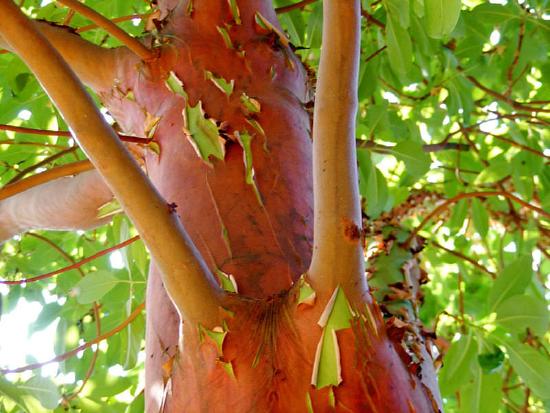
How does water get up? How does sugar move down?
What structures hold the plant upright? Are tree trunks also stems? Of course they are. Trees don't start out big and tall - they grow from small plants to large trees. And it is these stems that allow them to grow upright. So, obviously the stem is very important and has numerous functions.
Stems
In vascular plants, stems are the organs that hold plants upright so they can get the sunlight and air they need. Stems also bear leaves, flowers, cones, and secondary stems. These structures grow at points called nodes (shown in Figure below). At each node, there is a bud of meristem tissue that can divide and specialize to form a particular structure.
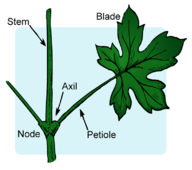 The stem of a vascular plant has nodes where leaves and other structures may grow.
The stem of a vascular plant has nodes where leaves and other structures may grow.Another vital function of stems is transporting water and minerals from roots to leaves and carrying food from leaves to the rest of the plant. Without this connection between roots and leaves, plants could not survive high above ground in the air. In many plants, stems also store food or water during cold or dry seasons.
Stem Diversity
Stems show variation because many stems are specialized. Figure below shows examples of stem specialization. With specialized stems, plants can exploit a diversity of niches in virtually all terrestrial ecosystems.
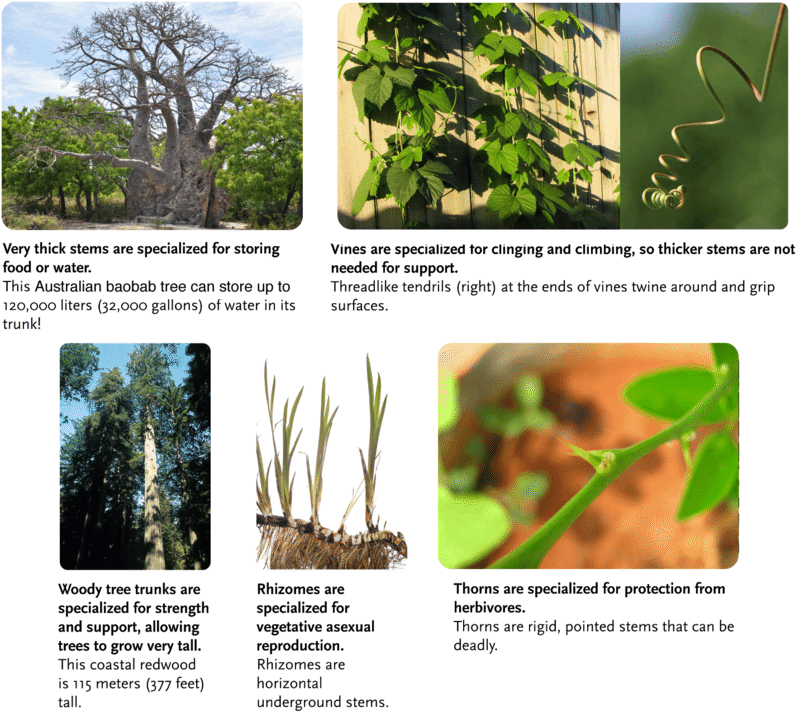 Stem specializations such as these let plants grow in many different habitats.
Stem specializations such as these let plants grow in many different habitats.Stem Tissues and Functions
Like roots, the stems of vascular plants are made of dermal, vascular, and ground tissues.
- A single-celled layer of epidermis protects and waterproofs the stem and controls gas exchange.
- In trees, some of the epidermal tissue is replaced by bark. Bark is a combination of tissues that provides a tough, woody external covering on the stems of trees. The inner part of bark is alive and growing; the outer part is dead and provides strength, support, and protection.
- Ground tissue forms the interior of the stem. The large central vacuoles of ground tissue cells fill with water to support the plant. The cells may also store food.
- Bundles of vascular tissue run through the ground tissue of a stem and transport fluids. Plants may vary in how these bundles are arranged.
Stem Growth
The stems of all vascular plants get longer through primary growth. This occurs in primary meristem at the tips and nodes of the stems. Most stems also grow in thickness through secondary growth. This occurs in secondary meristem, which is located in and around the vascular tissues. Secondary growth forms secondary vascular tissues and bark. In many trees, the yearly growth of new vascular tissues results in an annual growth ring like the one in Figure below. When a tree is cut down, the rings in the trunk can be counted to estimate the tree’s age.
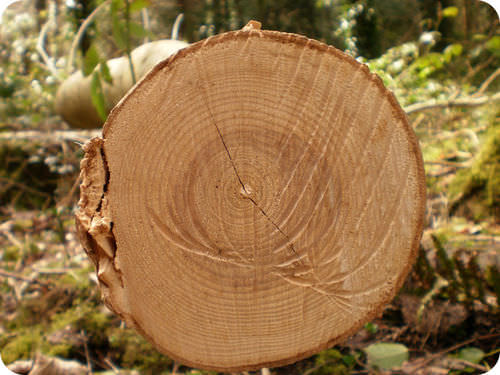 The number of rings in this cross-section of tree trunk show how many years the tree lived. What does each ring represent?
The number of rings in this cross-section of tree trunk show how many years the tree lived. What does each ring represent?Summary
- Stems hold plants upright, bear leaves and other structures, and transport fluids between roots and leaves.
- Like roots, stems contain dermal, ground, and vascular tissues.
- Trees have woody stems covered with bark.
Review
- Describe two types of specialized stems. What is each type of stem specialized for?
- What is bark? What purposes does it serve?
- Apply lesson concepts to predict how the stem of a desert plant might be specialized for its environment.
| Image | Reference | Attributions |
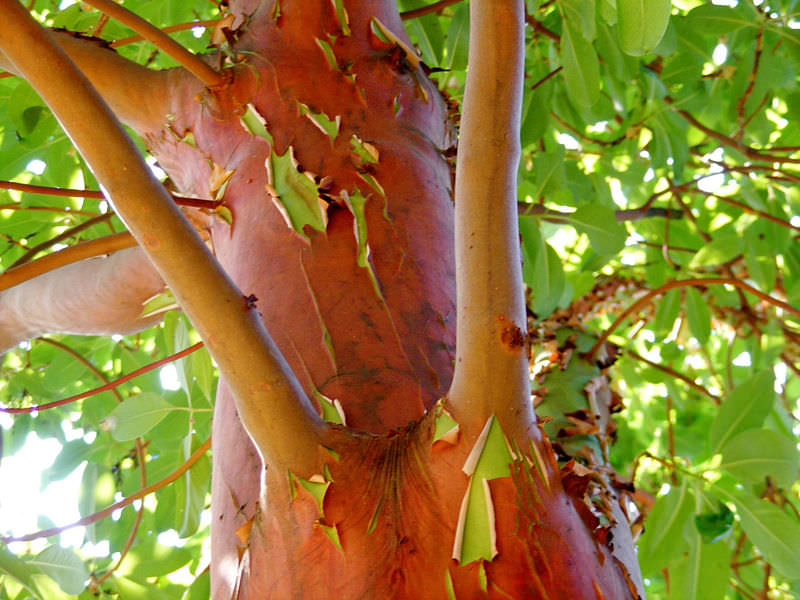 |
[Figure 1] | Credit: Amanda Tromley (www.outofthefireblog.com) Source: http://www.flickr.com/photos/out_of_the_fire_blog/4516065674/ License: CC BY 2.0 |
 |
[Figure 2] | Credit: Mariana Ruiz Villarreal (LadyofHats) for CK-12 Foundation Source: CK-12 Foundation License: CC BY-NC 3.0 |
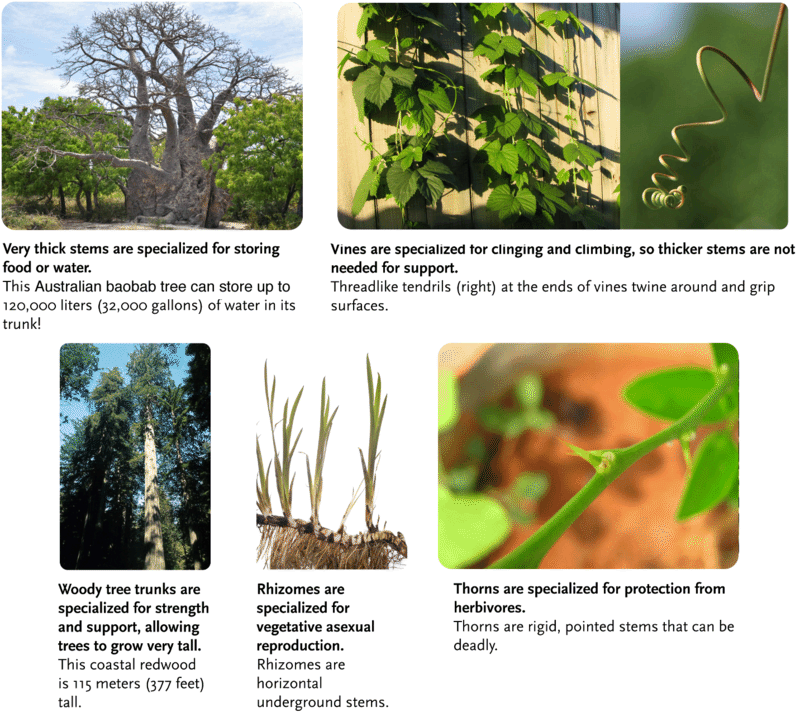 |
[Figure 3] | Credit: Baobab: Amila Tennakoon; Redwood: Courtesy of National Park Service; Vines: Flickr:epicbeer; Vine tendril: Jon Sullivan; Rhizomes: Image copyright dabjola, 2014; Thorns: Trilok Rangan Source: Baobab: http://www.flickr.com/photos/lakpura/5997342707/ ; Redwood: commons.wikimedia.org/wiki/File:Coastal_redwood.jpg ; Vines: http://www.flickr.com/photos/epicbeer/3146388362/ ; Vine tendril: commons.wikimedia.org/wiki/File:Vine.jpg ; Rhizomes: http://www.shutterstock.com ; Thorns: http://www.flickr.com/photos/logrcubed/4492462187/ License: Baobab: CC BY 2.0; Redwood: Public Domain; Vines: CC BY 2.0; Vine Tendril: Public Domain; Rhizomes: License from Shutterstock; Thorns: CC BY 2.0 |
 |
[Figure 4] | Credit: Amanda Tromley (www.outofthefireblog.com) Source: http://www.flickr.com/photos/out_of_the_fire_blog/4516065674/ License: CC BY 2.0 |

